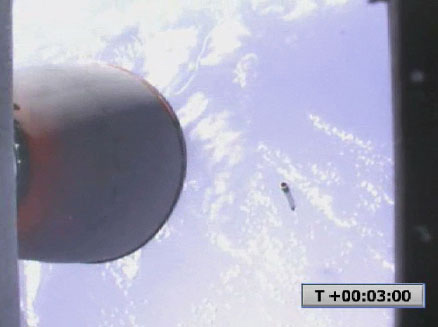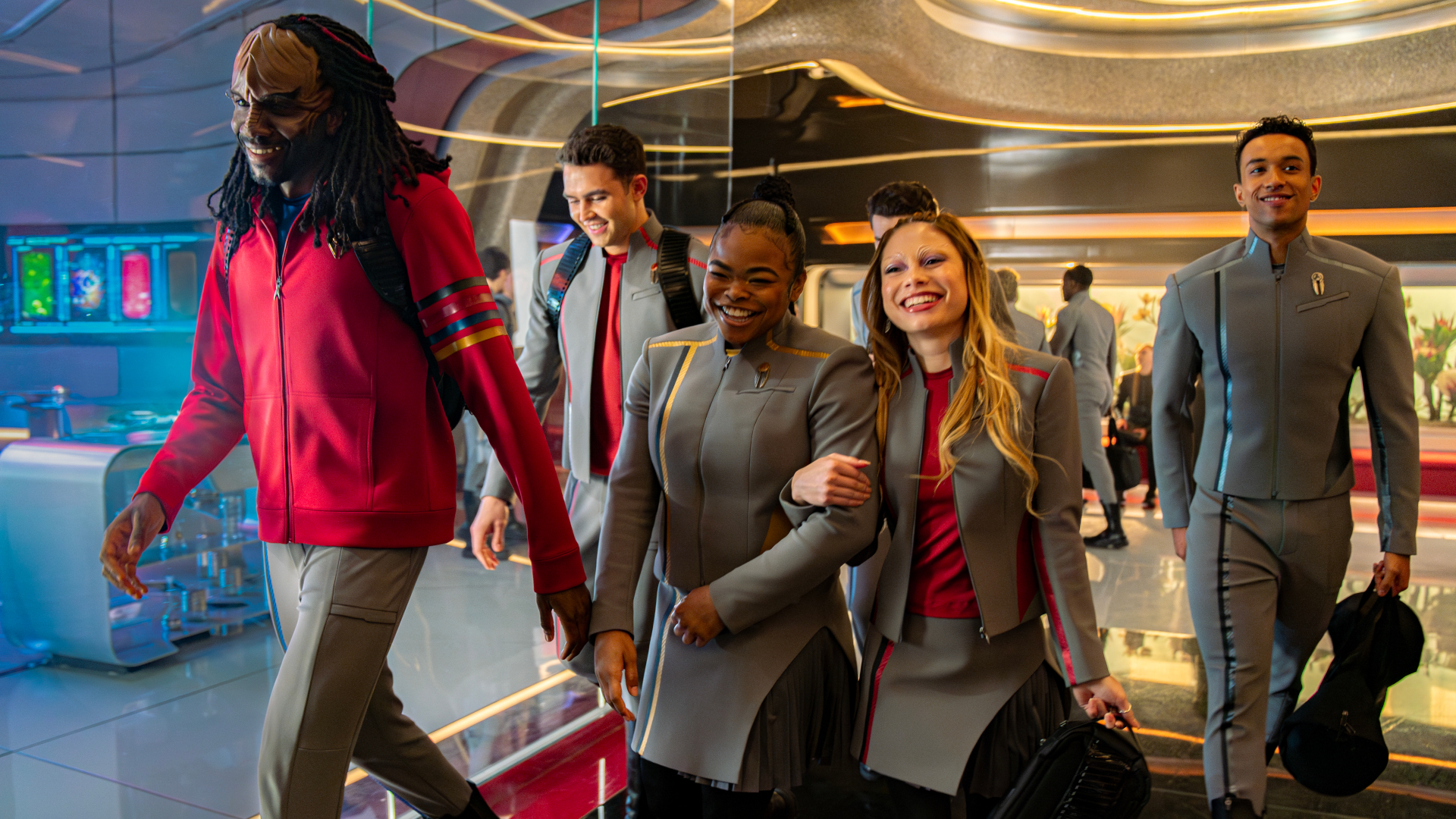SpaceX's Second Falcon 1 Rocket Fails to Reach Orbit

The secondtest flight of the privately-builtFalcon 1 rocket failed to reach its intended orbit late Tuesday, nearly oneyear to the day of the booster's ill-fatedspaceflight debut.
Thetwo-stage Falcon 1 rocket shot spaceward [image]from its Pacificisland launch site at 9:10 p.m. EDT (0110 March 21 GMT), but suffered aroll control malfunction 186 miles (300 kilometers) above Earth before completing its flight plan,its SpaceExploration Technologies (SpaceX) builders said. The rocket was intended toend its mission about 10 minutes after liftoff at an altitude of about 425 miles(685 kilometers).
- VIDEO: SpaceX's Homegrown Falcon 1 Rocket's Second Flight
"We didencounter, late in the second burn, a roll control anomaly," SpaceXCEO Elon Musk told reporters, after the more than five-minute spaceflight. "Butthat's something that's pretty straightforward to address."
The rollcontrol glitch affected how the Falcon 1 booster's second stage controlleditself in flight, sending the vehicle on a path that likely reentered the Earth'satmosphere over the Pacific Ocean without completing a full orbit, Musk said. Themalfunction could have been due to a range of issues, such as helium leak or aroll control jet glitch, but only a subsequent analysis will root out the cause,he added.
Theoff-nominal spaceflight capped a drama-filled countdown that included payload communicationsglitches and one pad abort a half-second after the Falcon 1 rocket's engineignited. Each of those issues was eventually resolved, and the rocket -- initially targeted for a 7:00 p.m. EDT (2300 GMT) liftoff after a Monday scrub -- was again readied for launch within its four-hour flight window.
"This was apretty nerve-wracking day," Musk said. "The rocket business is definitely not alow-stress business, that's for sure, but I don't think I'm disappointed. Infact, I'm pretty happy."
The factthat the Falcon 1 rocket lifted off from its Kwajalein Atoll launch site in thePacific Ocean, experienced successful first-stage and payload fairingseparations [image]-- as well as the ignition of its second stage -- proved that hundreds ofbooster improvements incorporated into the vehicle since its firstMarch 2006 failure were a success, the SpaceX chief said.
Breaking space news, the latest updates on rocket launches, skywatching events and more!
"Wesuccessfully reached space, and really retired almost all of the riskassociated with the rocket," Musk added.
Asuccessful demonstration
SpaceXlaunched the Falcon 1 rocket primarily as a demonstration for the U.S. DefenseAdvanced Research Projects Agency to prove the booster's capabilities, thoughthe rocket also carried a 110-pound (50-kilogram) set of experiments, includingan automated flight safety system, low-cost satellite communications transceiver,and mechanical payload adapter ring.
"We, in the Washington D.C. office are celebrating with champagne," Gwynne Shotwell,SpaceX vice president of business development, told reporters after the launch."Falcon 1 clearly got to space."
Tuesday's launchmarked SpaceX's second Falcon 1 test flight after a fuelleak and fire led to the failure of its inaugural space shot last year [image]. Initially attributed to human error, the failed launch was ultimately found tobe the result of a corroded aluminum nut, prompting the El Segundo,California-based firm to institute a host of rocketand ground facility improvements.
"It didn'ttake us one year to build the new rocket," Musk told SPACE.com before Tuesday'sspace shot. "The delay of one year was used to allow us to develop the Falcon1, version two."
Standingabout 68 feet (21 meters) tall, SpaceX's Falcon 1 rocket is a two-stage boosterdesigned to carry satellite payloads of up to 1,256 pounds (570 kilograms) intolow-Earth orbit for a flat price of about $7 million per space shot.
The rocket'sfirst stage is designed to be reusable, and carries parachutes to slow itsdescent and make a splashdown landing in the Pacific Ocean for later retrieval andrefurbishment.
"The firststage should be currently floating around the Pacific Ocean, with our recoveryboat in hot pursuit," Musk said after Tuesday's launch.
Flights shouldresume
Musk saidhas said repeatedly that he firmly believed that any serious glitch to afflict thesecond Falcon 1 test would not prompt another one-year delay in flights.
SpaceXplans to launch at least two more Falcon 1 rockets this year, including asummer space shot to orbit the U.S. Naval Research Laboratory's TacSat-1satellite and a third mission to launch Malaysia's Razaksat Earth-observationsatellite. Both customers have pledged to stand by SpaceX, with the Razaksatteam offering a hearty congratulations following Tuesday's liftoff, SpaceXofficials said.
"We feellike there's really no need for an extra test flight," Musk told reporters.
SpaceX'sFalcon 1 rocket is not only aimed at providing low-cost satellite launches. Italso serves as a precursor to the launch firm's planned Falcon 9 rocket, aheavy-lift booster currently under development to loft the firm's manned Dragonspacecraft.
- VIDEO: SpaceX Simulates Dragon's Flight to ISS
Slated tomake its first test flight in 2009, SpaceX's Dragon vehicle is the launch firm'sentry in NASA's CommercialOrbital Transportation System (COTS), a program aimed at finding private crew andcargo services to support the International SpaceStation (ISS). But those future Falcon 9 flights are linked to the successof Falcon 1, Musk has told SPACE.com.
Patti GraceSmith, the Federal Aviation Administration's associate administrator COTS,wished SpaceX and their Falcon 1 rocket luck during Tuesday, as did NASA administratorMike Griffin.
"I've got all fingers and toes crossed hoping that it works," Griffin told SpaceNews, a sister publication to SPACE.com, following his address atthe 45th Robert H. Goddard Memorial Space Symposium in Adelphi, Md.
Musk saidthat despite the early end to today's spaceflight, he considers the test asuccess and looks forward to the upcoming Falcon 1 missions.
"I think it'sfair to characterize this as a success and a good day," Musk said. "Not aperfect day, but a good day."
SpaceNews Staff Writer Brian Berger contributed to this report from Adelphi, Maryland.
- VIDEO: SpaceX's Homegrown Falcon 1 Rocket's Second Flight
- VIDEO: SpaceX Simulates Dragon's Flight to ISS
- Top 10 Imaginations at Work: Elon Musk
- IMAGES: Twenty Great Rocket Launches
- SpaceX Poised to Launch Second Falcon 1 Rocket
- Falcon 1 Failure Traced to a Busted Nut
- SpaceX's Inaugural Falcon 1 Rocket Lost Just After Launch
- Explore SPACE.com's Spaceflight Archive

Tariq is the award-winning Editor-in-Chief of Space.com and joined the team in 2001. He covers human spaceflight, as well as skywatching and entertainment. He became Space.com's Editor-in-Chief in 2019. Before joining Space.com, Tariq was a staff reporter for The Los Angeles Times covering education and city beats in La Habra, Fullerton and Huntington Beach. He's a recipient of the 2022 Harry Kolcum Award for excellence in space reporting and the 2025 Space Pioneer Award from the National Space Society. He is an Eagle Scout and Space Camp alum with journalism degrees from the USC and NYU. You can find Tariq at Space.com and as the co-host to the This Week In Space podcast on the TWiT network. To see his latest project, you can follow Tariq on Twitter @tariqjmalik.
